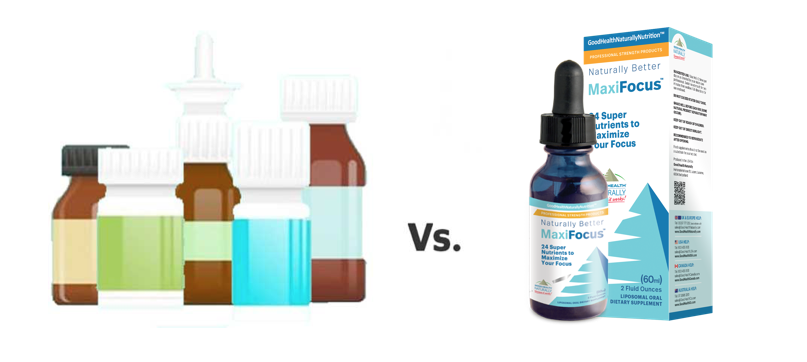Absorbed* (Approx) in a healthy system
| Product | 2mg daily Lutein Cost Maintenance | Amount needed | 10mg daily Lutein Cost Therapeutic | Amount needed | Total dose in Pack | Cost per Pack | Lutein available per dose* |
| NewFocus | 16p | 1 Spray | 83p | 6 Sprays | 160sprays | 24.95 | 2mg |
| I-Caps | 66p | 4 Tabs | £3.33p | 20 Tabs | 60 Tablets | 10.00 | 0.5mg |
| Ocuvite Lutein | £1.10 | 4 Tabs | £4.72 | 17 Tabs | 36 Tablets | 10.00 | 0.6mg |
| Quest Eye Nutrients | 62p | 4 Tabs | £3.13 | 17 Tabs | 30 Tablets | 9.39 | 0.6mg |
| Vision Ace | 1.16p | 5 Caps | £5.75 | 25 Tabs | 30 Caps | 7.00 | 0.4mg |
| Lycopene Carotene | £1.00 | 2 Caps | £5.00 | 10 Caps | 30 Caps | 15.00 | 1.00mg |
| VisualEyes | 30p | 2 Caps | £3.00 | 9 Caps | 30 Caps | 9.00 | 1.00 |
| Centrum Silver | £13.00 | 80 Tabs | £132.00 | 400 Tabs | 30 Tabs | 10.00 | 0.025mg |
| Sanatogen Gold | £7.99 | 72 Tabs | £40.00 | 363 Tabs | 90 Tabs | 10.00 | 0.0275mg |
*Absorption Ratesonly in a HEALTHY Digestive tract. Absorption of Lutein available per dose from tablets and Caps may decrease if unhealthy tract. Intra-Oral is not effected by digestive tract health. The Lutein Antioxidant Supplementation Trial (LAST)
The following is a transcript of the abstract to be presented at ARVO 2002 meeting by: S.P. Richer-1, W.Stiles-1, L.Statkute-2, K. Y. Pei-1, J.Frankowski-1, J.Nyland-1, J.Pulido-3, D.Rudy-4.
- Eye Clinic, DVA Medical Centre, North Chicago, IL, USA
- Cook County Hospital, Chicago, IL, USA
- Eye and Ear Infirmary, UIC, Chicago, IL, USA
- Family Medicine, FUHS/Chicago Medical School, North Chicago, IL, USA.
Main Findings:
|
Objectives:
Age Related Macular Degeneration (AMD) is the leading cause of loss of vision in ageing western societies, accounting for well over half of visual disability in the United States. The atrophic variety constitutes 90 % of cases and is without an accepted standardised evaluation and treatment protocol. In this abstract the authors describe an intervention treatment study of atrophic AMD using a standardised protocol and nutritional supplementation.
Methods:
The design was a prospective 12-month, placebo controlled, double blind, repeated measures and crossover clinical trial of Lutein vs. Lutein plus antioxidants on 90 mostly male outpatient veterans (74.7 yrs +1- 7.1 yrs) with atrophic (dry form) AMD. A serial-visit clinical evaluation protocol previously described and validated with a pilot case series data (Richer et al, JAOA 1999; 70: 13-23) was used.
Ophthalmic measures were macular pigment optical density (MPOD), lens opacification rating, contrast sensitivity (CSF), low-luminance low-contrast visual acuity, glare recovery (GR) and activities of daily living associated with AMD (night driving / glare adaptation disturbance).
Results:
The three treatment groups (10 mg Lutein, 10 mg Lutein plus antioxidants and placebo) were matched for: age, years diagnosed with AMD, smoking/cardiovascular history, iris colour, lens opacification and nutritional status/physical activity level.
Average eye MPOD, as measured by heterochromic flicker photometry, increased on average by 0.09 log units (repeated factors ANOVA; p<0.05), or 50 % in both the Lutein and Lutein plus antioxidant treatment groups by 12 months. There was statistically significant concurrent improvement in some measures of visual function including GR, CSF and distance/near visual acuity in both treatment groups. Crossover, double crossover and video-documentation of patient symptoms pre and post treatment, were consistent with objective data. Inclusion of multiple nutrients (besides Lutein) appears to provide an added improvement to CSF.
Summary of the main outcome of the LAST relatively to the placebo group.
|
Conclusions:
Reversibility of AMD symptoms has important biophysical, physiological and clinical implications. This population prospective clinical trial agrees with previous studies suggesting AMD to be a nutrition responsive disorder. The authors believe that low technology visual evaluation protocols, combined with Lutein based nutritional intervention recommendations may improve the eye health of older patients with the dry form of AMD.

